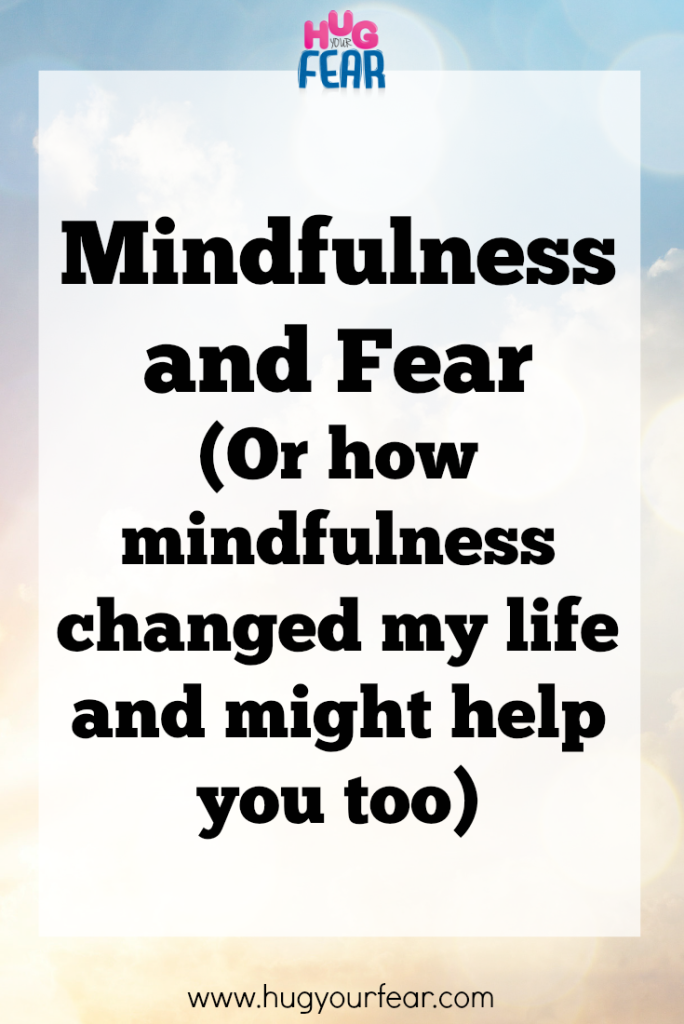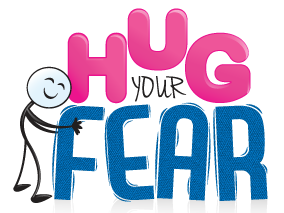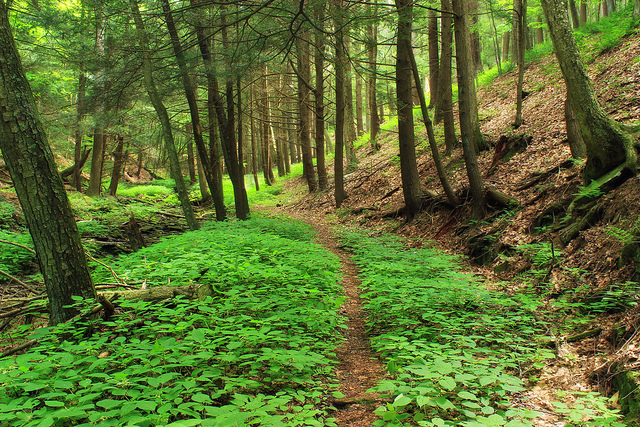 I’d like to let you in on a practice that is changing the way that I manage fear, anxiety and other sometimes scary emotions.
I’d like to let you in on a practice that is changing the way that I manage fear, anxiety and other sometimes scary emotions.
The practice is called mindfulness.
You’ve likely heard about it in the news or on health or meditation blogs or maybe even practice some mindfulness techniques already. If you haven’t, that’s ok too.
Since my pre-teen years, I’ve been a self-help book junkie. I would try and get my hands on any book that seemed to promise me a way to get rid of fear or anxiety or sadness, basically any feeling that felt too hard to handle.
Resistance was the name of the game.
As I got older, I began to see a pattern forming: Get frustrated because I was scared or sad, wish I didn’t feel that way anymore, seek out a book that hinted at a future of fearlessness or endless happiness, get halfway through the book, realize that the fear or sadness was still there and then repeat from step one.
There has got to be a better way, I would journal to myself. There has got to be a way to get rid of these feelings so that I can finally be happy and at peace!
Well, I think I found my answer, but it is completely opposite town from where I thought I wanted to be.
Enter mindfulness.
I heard about mindfulness a few years ago when an 8-week course was being offered at the local YMCA. It was based on a process called Mindfulness Based Stress Reduction (MBSR) created by a man named Jon Kabat-Zinn. MBSR was originally created as a way for him to help people who were ill and considered past the point of help by their doctors. Dr. Kabat-Zinn found a way to help these people manage their illness and find acceptance and peace of mind by using mindfulness principles and meditation. Since then, his 8-week course has broadened to include everyone, not just the chronically or terminally ill, and is taught by trained teachers around the world.
It took me a couple more years and one false start to finally sign up for the class, but I started it in the beginning of 2014.
When I originally signed up for the class, I actually thought it was only going to teach me how to meditate for longer periods of time and while the class was about meditation, it was also about so much more.
In the end, it wasn’t the 30+ minute meditations that stuck, but the principles of mindfulness and how they have been progressively opening me up to a new way of being with myself, fear, anxiety, pain, illness, doubt and any other emotion or sensation that I would’ve once labeled “bad.”
Now I won’t pretend to distill an 8-week course and almost a year of unpacking and practicing what I’ve learned into one blog post, but I’d like to share just three things that might be helpful to you as you deal with fear or anxiety or any other feeling you’ve called “bad” based on what I’ve learned and experienced.
The first is the key that unlocks the true power of mindfulness.
Learn how to observe whatever comes up in your body and in your mind without judging it.
That’s it.
That is the core focus of mindfulness, nonjudgmental awareness and acceptance of what is.
It’s taken me a while to sit with this and see the beauty in it, but I will admit, I was (and sometimes still am) a bit attached to the idea that our mission as humans is to find what we don’t like in ourselves and do our best to blot it out.
I’ve tried that mission (and sometimes I forget and still try) and perhaps you try it too, but have you realized that in the end it doesn’t really work or at least not for long? And then you feel worse about yourself which just adds to the fear and pain that was there before. Right?
Once you are able to realize that you are not your thoughts or feelings or bodily sensations and that they are just things that are happening in and around you that you can observe (without judgment), your antagonistic relationship will soften and transform into something else.
As Ruth Baer, Ph.D. says in her helpful book on mindfulness, The Practicing Happiness Workbook,
[quote align=”center” color=”#EB148D”]”Thoughts and feelings are like visitors; they come and go. We enjoy some of them and dislike others. Either way, we can learn from them. Most importantly, we don’t have to be controlled by them.”[/quote]
So how in the world do you observe these things? Is observing without judgment even possible?
Good question. It’s one I’m still learning to answer.
The practice that’s helped me the most thus far with learning how to observe what comes up without judgment is meditation.
Isn’t it ironic that the answer I’ve found to fighting against my fear is essentially sitting in silence not doing anything?
Meditation is helpful because it lets you practice observation in a somewhat controlled environment. You just sit for a certain amount of time and notice what comes up.
A helpful tip I heard before is to imagine that there is a you who is experiencing things and another you who is observing what the first you is experiencing.
And again, that’s it.
Ok, of course there’s more to it, but that is basically the bulk of it.
The more you sit and observe and maybe even mentally name what you observe, the more familiar it gets.
And here’s where the tough part comes, unlike the promises of so many self-help philosophies, meditation and mindfulness are progressive in their effectiveness. It takes repeated practice to see any change.
But it’s worth it, even in small doses. Lately, I’ve been meditating only 5 minutes each day and I still feel the impact. I know that more would likely be better, but I like to believe that 5 minutes consistently is better than 30 minutes once every couple of months.
So far I’ve slowly noticed how much more aware I am of my surroundings, my thoughts, my emotions and my body. The scary stuff hasn’t gone away, but my relationship to it has changed.
I’ve also noticed since practicing that I’ve begun to transfer what I’m learning by sitting in meditation to the rest of my daily life.
Take this aha moment I had as an example.
One focus of meditation is the breath (which I’ll say even more about next). You basically use your breath as a focus point that you can come back to again and again when you find that you are following your wandering mind (which naturally wanders a lot).
Well, my aha came when I was up and about ruminating about something and going down one of those slippery anxious thought spirals and I thought to myself, just “return to the breath”. I focused on a few deep breaths, observed that the thought spiral was just that, a thought spiral and I didn’t have to follow it and then moved on to something else. For someone who if they were giving out medals for rumination would be a multi-year, world-record breaking, gold medal holder, this simple, low-key moment made me realize that there is something truly powerful to mindful awareness and meditation.
And while I’m not sure this is relevant to everyone who reads this or even desirable, for the few to whom this sounds good, I wish this or another low-key and paradigm shifting moment for you too whether you get there by meditation or some other mindful practice.
And just in case this sounds too good to be true, note that it is a process. Sometimes it takes me few minutes to come back and sometimes a few days or more. There are also times when all I can do is be aware of the fear or pain or sadness when it is happening and just sit back and let it roll through.
This may sound like hell, especially if you’ve lived by an “avoid anything scary at all costs” motto, but knowing that you can sit with the scary stuff, observe it and then move on eventually is still pretty powerful stuff.
And finally, the breath. As I mentioned above, the breath is often a focus point used in meditation to help you center yourself and detach somewhat from your roaming thoughts or pain in your physical or emotional body.
Fear and anxiety are both characterized by short, shallow breathing. And if you are anything like me and have a long history of feeling afraid or anxious, you likely take short, shallow breaths as a rule rather than an exception just out of habit.
Deep belly breaths are important, and can help you calm down, but they need to be practiced. And that practice ideally happens when you are calm.
This somewhat obvious realization was one I made recently after trying to take deep breaths while in the middle of a panic attack. It’s easy to believe that you can’t swim when you take lessons in the ocean in the middle of a storm. Practice deep breathing before you need it.
Taking deep breaths helps with mindful awareness of the moment by bringing you back to the moment. Breathing is something that is happening right now, it’s the perfect proxy for present moment living. It is present moment living.
There are many breathing exercises out there to help you learn how to consciously breathe deeper, but one that has worked for me is taking a deep breath in, then blowing out all the air that I can pretty forcefully from my mouth, and then letting the air naturally fill back in and expand my stomach while I breathe in through my nose. After I get this one going, I continue to breathe deeply in through my nose and out through my mouth for a few breaths while trying to relax my shoulders and face muscles.
And if you’re feeling fancy, you can practice deep breathing by practicing it with light body movements. One of my favorites that I do most mornings is a 5-10 minute energy routine by Donna Eden seen here. I have found that when I do this and breathe deeply, I am training myself to relax my mind and my body (even though that’s not the main point of this particular video). Of course, this is what works for me. Maybe for you it’s taking a mindful walk while you breathe deeply or doing martial arts or painting or yoga or cycling.
Whatever it is, practicing deep breathing while moving when you are relatively calm can help you breathe deeper when you do have a moment of anxiety or fear or sadness. Instead of it being some new technique you are trying to get to work when you’re freaking out, you will simply be exercising a deep breathing and relaxation habit that you’ve created beforehand which makes a huge difference.
I hope this has been helpful to you in some way.
Please leave a comment with your thoughts on mindfulness or meditation or deep breathing.
If you’re interested in learning more, here are a few books that I can recommend (these are affiliate links, if you click and buy, I will receive a small portion at no extra cost to you. Thank you if you decide to support me in this way!):
Full Catastrophe Living by Jon Kabat-Zinn, PhD
The Practicing Happiness Workbook: How Mindfulness Can Free You From the 4 Psychological Traps that Keep You Stressed, Anxious and Depressed by Ruth Baer, PhD
Sane New World: A User’s Guide to the Normal-Crazy Mind by Ruby Wax
Image: Early-Morning Hike (1) by Nicholas A. Tonelli


